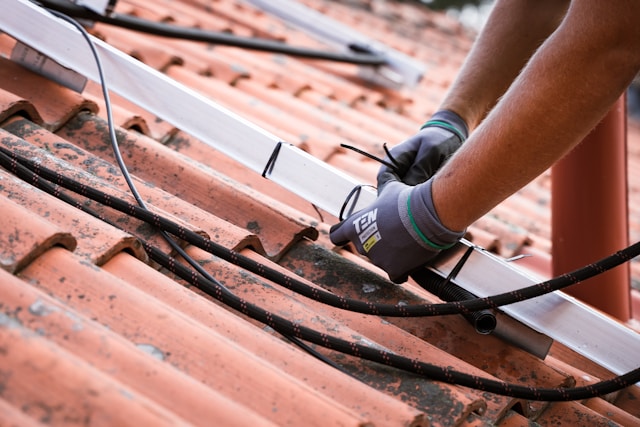The Role of Chimney Flashing in Roof Protection: What G.I.G Strongsville Looks for During Inspections
May 26, 2025Chimney flashing is essential for preventing roof leaks and moisture damage, and during inspections, G.I.G Strongsville checks the flashing materials, placement, and surrounding seal points to identify early signs of failure. You should be aware of warning signs like rusted metal, improper layering, and cracked mortar, as these issues can let water seep behind walls or into attics. By ensuring proper flashing, you protect not just your roof but also the structural integrity and energy efficiency of your home.

Why Chimney Flashing Is One of the Most Important Parts of Your Roof
When inspecting your roof, it’s essential to focus on the chimney flashing, as it plays an important role in preventing water leaks and moisture damage. Properly layered flashing protects against these issues by ensuring a watertight seal where the chimney intersects the roof. By checking for signs of rust, improper layering, and cracked mortar, you can identify early failures that could lead to significant structural and insulation problems.
Properly layered flashing protects against water leaks and long-term roof damage
Properly layered flashing is your roof’s first line of defense against water leaks and long-term damage. During a chimney flashing inspection in Strongsville, OH, look for signs of flashing failure like rusted metal or cracked mortar. These issues can lead to chimney flashing water damage, reducing your roof’s energy efficiency. Guarantee your flashing includes step, counter, and base layers to maintain watertight seals and prevent structural damage.
The Top Warning Signs of Flashing Failure You Shouldn’t Ignore
When inspecting your chimney flashing, look for signs like water stains on your ceiling or walls, rust marks on the flashing, and gaps in the caulking or mortar. These indicators can signal that water is seeping in, compromising the integrity of your roof. Additionally, check for cracked or loose flashing, discolored bricks, and mold or mildew growth, as these are clear warnings of flashing failure.
From rust to cracked mortar, what G.I.G looks for during inspections
During chimney inspections, G.I.G Strongsville closely examines the condition of the chimney flashing to identify potential failures that could lead to costly water damage. Here are key areas they focus on:
- Rust and Corrosion: Check for rust spots on metal flashing, indicating compromised waterproofing.
- Cracked Mortar: Inspect for cracks in the mortar that can allow water to seep in.
- Leaks Around the Chimney: Look for signs of leaks or dampness inside the home.
- Cracks or Gaps in Flashing: Identify any cracks or gaps in the flashing that could let water penetrate.
How Flashing Protects More Than Just Your Roof
When chimney flashing is properly installed and maintained, it not only protects your roof but also preserves the attic insulation and boosts your home’s energy efficiency. Tight seals around the chimney prevent moisture from seeping in, which helps maintain the integrity of your insulation and reduces heat loss. This protection extends beyond the roof, ensuring your entire home remains dry and energy-efficient, even during Ohio’s harsh winters and rain-heavy seasons.
Tight seals preserve attic insulation and boost energy efficiency
Proper chimney flashing is essential for maintaining the integrity of your attic insulation and boosting energy efficiency. Here’s how tight seals make a difference:
- Prevents Roof Leaks: Stops water from seeping into the attic, protecting insulation and structural elements.
- Maintains Insulation Efficiency: Keeps attic insulation dry and effective, reducing heat loss and energy costs.
- Enhances Roof Longevity: Protects against rusted metal, improper layering, and cracked mortar, common issues in Strongsville roofing inspections.
- Supports Energy Savings: Guarantees that your attic remains well-insulated, contributing to better overall energy efficiency and comfort.
G.I.G Strongsville’s Expert Approach to Flashing Repair and Replacement
When addressing chimney flashing issues, G.I.G Strongsville’s experts conduct thorough visual checks and hands-on moisture testing to identify early signs of failure. They inspect the flashing materials, placement, and surrounding seal points to detect problems like rusted metal, improper layering, and cracked mortar. By doing so, they can prevent water seepage and guarantee your roof and attic remain dry and structurally sound.
From visual checks to hands-on moisture testing, here’s what sets them apart
During a roof inspection, G.I.G Strongsville’s experts start with a thorough visual check of the chimney flashing to identify any immediate signs of deterioration or misinstallation. Here’s what they look for:
- Visual Inspection: Check for rust, corrosion, or bending in the flashing.
- Gap and Separation Checks: Look for gaps between the flashing and the chimney or roof surface.
- Hands-On Testing: Gently press on the flashing to check for looseness or movement.
- Moisture Testing: Conduct tests to ascertain there is no water intrusion behind the flashing.
This meticulous approach helps in Ohio’s harsh weather conditions, guaranteeing effective roof leak prevention and maintaining roof longevity.

